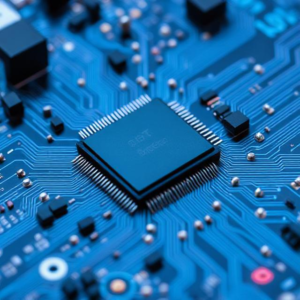What is a PMIC (Power Management IC)?
A Power Management IC (PMIC) is like the brain behind managing the power for your electronic devices. It helps control how power is distributed and used in devices like smartphones, laptops, tablets, wearables, and more.
In simpler terms, it’s a tiny chip that takes care of all the power-related tasks, making sure everything gets the right amount of energy to work properly, without wasting it.

Why are PMICs Important?
Electronic devices often have different components (like processors, memory, display, sensors, etc.) that need different levels of power to function. A PMIC makes sure that each of these parts gets the right amount of voltage and current, while also making the power usage efficient. Without a PMIC, it would be hard to manage all the different power needs and maintain battery life.
What Does a PMIC Do?
Here are the key jobs that a PMIC handles in a device:
- Power Conversion:
- Different parts of a device need different voltages to operate. For example, the processor might need 1.8V, while the display might need 3.3V.
- The PMIC takes the battery’s voltage (say, 3.7V) and converts it to the different voltages needed for each component. It does this using voltage regulators inside the chip.
- Power Distribution:
- The PMIC manages where the power goes and how it’s distributed to different parts of the device. It acts like a traffic controller, ensuring that each component gets the right amount of power without overwhelming the system.
- Battery Charging:
- PMICs also handle charging the device’s battery. They manage how much current is sent to the battery and when to stop charging to avoid overcharging, which could damage the battery.
- Some PMICs include battery management features, like keeping track of battery health, charging speed, and temperature monitoring.
- Power Efficiency:
- PMICs are designed to be very efficient. This means they make sure power is used effectively, preventing energy waste and extending battery life.
- They have features like power saving modes, where the PMIC can shut off certain components or reduce the power used when the device is idle.
- Protection:
- PMICs help protect devices from over-voltage, over-current, and thermal damage. If something goes wrong, like if the temperature gets too high, the PMIC can shut down certain parts to protect the device from damage.
Key Components of a PMIC:
Inside a PMIC, there are several important components that help it manage power efficiently:
- Voltage Regulators: These adjust the input voltage (from the battery or power supply) to different voltages that the components of the device need.
- Buck Converters: These are used to step down voltage. For example, they take a higher voltage (like 5V) and reduce it to a lower voltage (like 3.3V).
- Boost Converters: These do the opposite of buck converters—they step up the voltage. For example, increasing 3V to 5V for certain parts.
- LDO (Low Dropout Regulator): A type of voltage regulator that provides a steady voltage even when the input voltage is close to the output voltage. It’s used when you need a very clean and stable power supply.
- Battery Charging Circuit: Manages the charging process, making sure that the battery gets charged at the correct rate and doesn’t overheat.
Where are PMICs Used?
PMICs are used in almost all modern electronic devices, especially those that are battery-powered. Here are some examples:
- Smartphones: PMICs manage the power from the battery and ensure that each part of the phone (processor, display, camera, etc.) gets the right amount of power.
- Laptops and Tablets: Similar to smartphones, PMICs are used to manage the power distribution and charging, making sure the device operates efficiently.
- Wearable Devices (like smartwatches): These small devices rely heavily on power management to extend battery life.
- IoT Devices: Many small, battery-powered Internet of Things (IoT) devices use PMICs to efficiently manage power and improve battery life.
- Automotive Electronics: In cars, PMICs are used to handle power for things like infotainment systems, sensors, and lights.
How Does a PMIC Improve Battery Life?
Since PMICs control the power flow, they help make sure that a device’s battery lasts as long as possible. Here’s how:
- Efficient Power Conversion: PMICs convert the battery voltage to the correct voltage needed by each component, using the least amount of energy.
- Power Saving Features: PMICs can put certain parts of the device into low-power modes when not in use, saving battery life.
- Battery Charging Management: By controlling the charging process, the PMIC ensures the battery is charged safely and efficiently, preventing damage that could reduce its lifespan.
Summary:
In simple terms, a PMIC (Power Management IC) is a chip that helps manage how power is distributed and used in electronic devices, ensuring each component gets the right amount of energy without wasting it. It helps with things like voltage conversion, battery charging, power distribution, and overall power efficiency. PMICs are crucial for extending battery life and protecting devices from power-related issues.
Tags: automotive electronics, battery charging circuit, battery charging management, battery health monitoring, battery life extension, boost converters, buck converters, charging control, compact power solution, current regulation, device power safety, efficient power usage., electronic devices, energy saving, integrated power management, IoT devices, laptops, LDO regulator, low power modes, over-current protection, over-voltage protection, PMIC, Power, power controller, power conversion, power distribution, Power Efficiency, power flow control, power management chip, Power Management IC, power supply optimization, protection features, smartphones, tablets, Thermal protection, voltage regulation, Voltage Regulators, wearables


